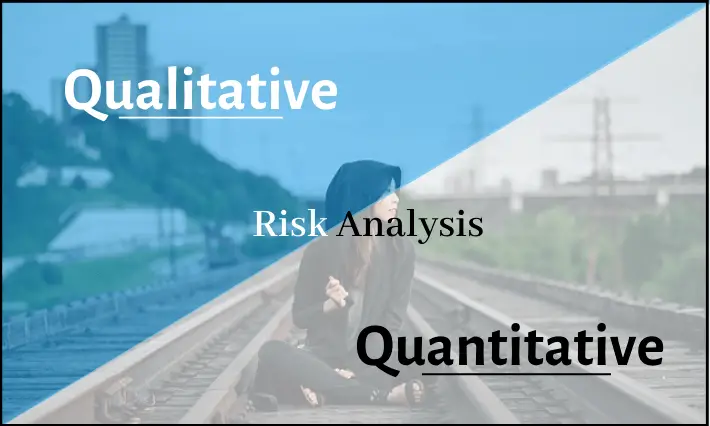There are many Project Management (PM) terms, which are slightly confusing and difficult to understand.
Qualitative Risk Analysis and Quantitative Risk Analysis are two such confusing terms. I have written this article to distinguish and differentiate between these terms. In addition, you will find detailed explanation of qualitative and quantitative Analysis techniques along with suitable examples. By the end of this post you will be able to do project risk assessment using these techniques.
This post will be extremely useful for you if you are preparing for the PMP exam. I have also thrown some light on the two PMBOK Guide’s project risk management processes viz. Perform Qualitative Risk Analysis and Perform Quantitative Risk Analysis.
Qualitative and Quantitative Risk Analysis
Do you know why there are so many confusing project management terms?
The only reason is PM books. They make project management difficult. They provide complex and convoluted explanations where a simple definition is sufficient.
In real life all these terms have simple English meanings. I would suggest you to understand the technical jargon only after understanding the meaning in English language. This way it there will be no confusion.
Let us look at Qualitative and Quantitative analysis.
Qualitative Risk Analysis – Definition, Meaning And Example
Let’s look at the English meaning of ‘Qualitative’.
relating to how good or bad something is
‘Qualitative’ clearly means that you are judging something on a subjective scale.
Let us look at a PM definition.
The examination and prioritizing of risk events by applying subjective judgment to the description, probability and impact of the event, typically on some numerical or graded scale.
This analysis can be done on any type of risk. It involves expert judgement and subjective analysis to grade a risk event. The grading can be done for probability and impact or any other project risk characteristic like urgency.
The grading is usually done on a pre-defined scale. The scale can be defined from low to high, or from 1 to 10 with 1 being the lowest, or on the basis of percentage (0%-100%).
For example, we might say that there is a ‘10%’ probability of not finishing the requirements document by the designated date and the impact of such an occurrence is ‘70%’.
Qualitative risk analysis is completely subjective. It is usually based on individuals’ perception and personal experiences. The benefit of this type of project management process is that it allows the project managers to minimize the level of uncertainty so that they can focus on the high priority risks.
Quantitative Risk Analysis – Definition, Meaning And Example
Let’s again start by looking at the English meaning of ‘Quantitative’.
relating to numbers or amounts
‘Quantitative’ clearly means that you are measuring something.
Let us look at a PM definition.
An examination of project risks using numerical processes such as simulation and decision trees.
This analysis can be used only if there is data available to measure & predict the probability and impact of a risk event. It typically involves numerically analyzing the effect of a risk even on time and cost. It calculates probability, impact, and severity on overall project objectives.
For example, we can do a proper evaluation of risk of delay in finishing the requirements document. Our analysis might suggest that organization will lose $10,000 for every one week of delay.
The benefit of this process is that it creates information of the quantitative risks to support the decision-making of project managers to minimize the uncertainty of the projects.
Difference Between Qualitative and Quantitative Analysis
| Qualitative Risk Analysis | Quantitative Risk Analysis | ||
|---|---|---|---|
| Typically performed on | All project risks | Risks prioritized through Qualitative analysis | |
| Typical evaluation of | Individual project risks | Overall project objectives | |
| Project size | Does not matter. Usually performed in every project. | Usually performed in large and complex projects. | |
| How? | Subjective judgement of probability and impact | Calculation and measurement of impact on project objectives (usually time and cost objectives) | |
| Effort involved? | Quick and easy | Time consuming and cost intensive | |
| Techniques | Expert judgment, PI analysis, urgency analysis | EMV analysis, Decision tree analysis, Monte Carlo simulation | |
| Main tools | none | Special tools and knowledge is required |
General Misconceptions
- Qualitative analysis cannot use numbers or percentages to grade P & I.
- Quantitative analysis is done only after Qualitative analysis
- Quantitative analysis is done only for time and cost objectives
- Quantitative analysis cannot done on individual project risks
- Probability cannot be numerically evaluated in Quantitative analysis.
Over To You
Do you us Quantitative risk analysis in your projects? What tools do you use for doing this analysis?
Please leave a comment.




![Start to Finish [SF] Relationship (Dependency) With Examples](https://www.pmbypm.com/wp-content/uploads/2014/06/start-to-finsh.jpg)




Sir,
Thank you very much for these clear explanations.
Good comparison between them.
I really enjoyed your article. Helpful information for me. Thanks for your work.